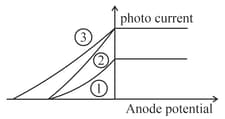EASY
Earn 100
A free particle having one electronic charge with initial kinetic energy and de Broglie wavelength enters a region of potential difference such that new de Broglie wavelength is now . Then is
(a)
(b)
(c)
(d)
100% studentsanswered this correctly
Important Questions on Dual Nature of Radiation and Matter
EASY
(Assume mass of electron and Charge of electron )
EASY
EASY
The photoelectric threshold for a certain metal surface is . If the metal surface is irradiated by a wavelength of , the kinetic energy of the emitted photoelectrons is
EASY
EASY
Given (in )
EASY
MEDIUM
EASY
EASY
EASY
EASY
EASY
EASY
EASY
The following graph represents the variation of photo current with anode potential for a metal surface. Here and represents intensities and represents frequency for curves and respectively, then

EASY
EASY
EASY
EASY
EASY
EASY
( = Planck's constant, = speed of light)

